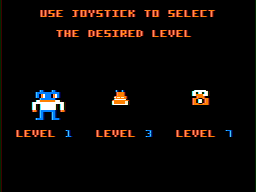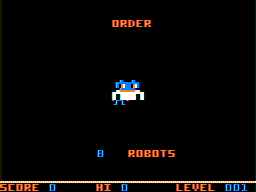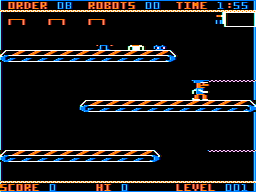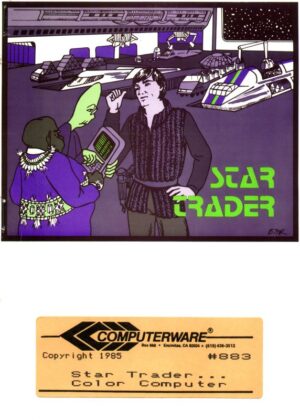Retro Replay Review
Gameplay
Panic Button places you in the fast-paced environment of a multi-level manufacturing line where efficiency and precision are everything. You’ll race against a two-minute timer on each level, assembling intricate products by collecting and stacking components that drop from three staggered chutes. The catch? You can only carry one part at a time, and every piece must be placed in the correct order—feet on the bottom, torso in the middle, and head on top for a robot, for example.
(HEY YOU!! We hope you enjoy! We try not to run ads. So basically, this is a very expensive hobby running this site. Please consider joining us for updates, forums, and more. Network w/ us to make some cash or friends while retro gaming, and you can win some free retro games for posting. Okay, carry on 👍)
As you progress, the conveyor belts speed up, demand rises, and the risk of misplaced parts increases. A single misstep—dropping a torso before the feet, for instance—renders that product useless, forcing you to start over or shift focus to a fresh assembly. Adding to the challenge, stray pieces can tumble off chutes and land atop your completed builds, potentially ruining hours of hard work if you’re not quick to clear them away.
One of Panic Button’s standout mechanics is the titular emergency button located at the upper right of the screen. Hit it to freeze all conveyor belts for a precious few seconds, giving you a moment to catch up when the action becomes overwhelming. Judicious use of this “panic button” can be a lifesaver, but resources are limited—overuse may leave you defenseless when you really need that breather.
Graphics
Visually, Panic Button embraces a clean, arcade-style aesthetic that prioritizes clarity over flashy effects. The chutes, parts, and assembled products are rendered in bright, contrasting colors so you can easily distinguish feet, torsos, heads, and faulty components at a glance. This simplicity is crucial when you’re frantically dashing from chute to chute under time pressure.
The staggered conveyor belts and multiple drop points are represented with crisp, minimalist lines that keep the screen from feeling cluttered even at higher speeds. Animations are smooth, from the satisfying snap of parts locking together to the comedic bounce of defective products when they collide with a completed build. These small flourishes add personality to the game without distracting from the core assembly mechanics.
While Panic Button doesn’t push the boundaries of graphical realism, its visual design is perfectly suited to its gameplay. Every piece of art serves a functional purpose—highlighting interactive elements, signaling imminent drops, or indicating when the panic button is available. The palette remains consistent across levels, ensuring you never lose track of essential details as the conveyor belts whip by faster and faster.
Story
Panic Button doesn’t rely on a deep narrative or elaborate world-building; instead, it frames its challenge within the universal tale of “beat the clock to meet the quota.” You step into the shoes of a dedicated factory worker racing to fulfill orders before the buzzer sounds. Though the story is minimal, it provides just enough context to make each level feel purposeful.
As you climb through increasingly demanding stages, there’s an implicit undercurrent of workplace camaraderie and competitive spirit. Will you emerge as the top assembler, celebrated by your coworkers and supervisors alike? The game’s sparse storytelling invites you to imagine the stakes and rewards beyond the screen, whether it’s a pat on the back or the satisfaction of nailing a perfect run.
Occasional on-screen messages congratulate you for milestones—”Halfway There!” or “Speed Demon!”—offering the only real narrative beats. These quips add a touch of personality and encourage you to push further, transforming what could be a purely mechanical exercise into an engaging race against both time and your own improving skills.
Overall Experience
Panic Button delivers a refreshingly original take on time-management puzzle games. Its blend of frantic, precision-based assembly and the strategic use of a limited emergency freeze button keeps the gameplay loop compelling from start to finish. Each level’s escalating speed ensures you’re constantly adapting, making for an addictive challenge that rewards quick thinking and dexterous movement.
Replayability is high: you’ll find yourself returning to earlier stages to beat your own records or tackling higher levels just to see how far you can push your reflexes. The straightforward presentation and lack of superfluous menus mean you’re always just a button press away from jumping right back into the fray.
Ideal for players who enjoy fast-paced puzzle action and have a keen eye for detail, Panic Button strikes a perfect balance between accessibility and depth. It may not boast a cinematic storyline or hyper-realistic graphics, but its crisp design, lively pace, and clever mechanics make it a standout title for anyone looking to test their assembly-line prowess under pressure.
 Retro Replay Retro Replay gaming reviews, news, emulation, geek stuff and more!
Retro Replay Retro Replay gaming reviews, news, emulation, geek stuff and more!







Reviews
There are no reviews yet.